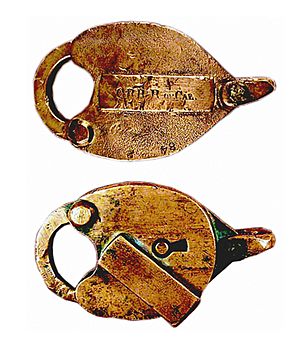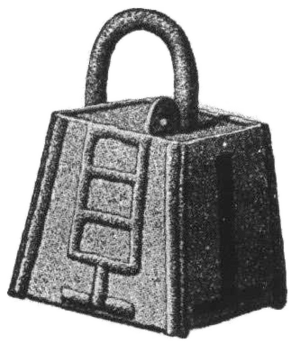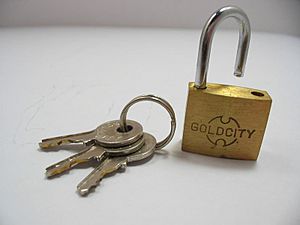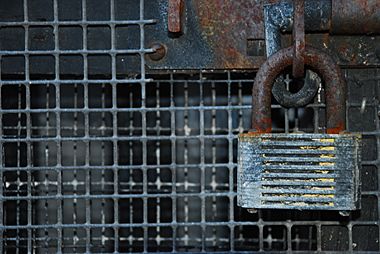Padlock facts for kids


A padlock is a type of lock you can carry around. It has a U-shaped part called a shackle. This shackle stays locked until you use the right key or dial the correct combination. Because of its U-shape, a padlock can be used in many ways. People often use them to lock two things together. For example, you might use a padlock to secure a door to its frame, or to join two chains.
Padlocks are usually not used for very high-security places. This is because the shackle can sometimes be cut with tools like a bolt cutter or a hacksaw. However, some newer padlocks have very strong shackles. These are made from tough materials like boron alloy steel. Some even have a hidden or covered shackle to make them harder to cut.
Contents
How Padlocks Are Made
There are different ways padlocks are built. A combination padlock often has a metal "can" with three spinning parts inside. These parts are connected to a dial on the front. This system works a lot like the one found in safes. When you enter the correct combination, the spinning parts line up. This lets a latch drop into place, which then opens the shackle. Combination locks are not always good for outdoor use. This is because rain water can get inside and cause them to rust.
Another type is the laminated padlock. This one is made from many metal plates joined together with rivets. The shackle of most padlocks is made from hardened steel. More expensive padlocks might use boron alloy steels. These are much harder to cut. Cheaper padlocks usually have shackles made of regular steel. If a padlock needs to resist corrosion (rust), its shackle might be made of brass or stainless steel. However, these materials are softer and easier to cut.
You can often tell what a shackle is made of by a stamp on its center. For example, a hardened steel shackle might say "HARDENED." A boron alloy shackle might be stamped "BORON ALLOY." Steel alloys that are treated with heat are much harder to cut. Alloy steel shackles are often covered with another metal like nickel or chrome. This helps protect them from rust. The body of the padlock is usually also covered. Brass and stainless steel padlocks don't need this covering, but sometimes they get it for a nicer look.
What the Shackle Stamp Means
The stamp on a padlock's shackle tells you what material it is made from. Here are some common stamps:
- Hardened - This means it's made of hardened steel, which is very common.
- Case hard - Also hardened steel, often found on older padlocks.
- Stainless - This means Stainless steel.
- Boron alloy - This is a very strong Boron alloy steel.
- Boron carbide - Found on some very strong padlocks like the Master Lock Magnum.
- Special alloy - Found on some Abus padlocks.
- Molybdenum - This means Molybdenum alloy steel.
- Unstamped - If there's no stamp, it's usually normal steel (if it's silver) or brass (if it's gold).
Common Uses for Padlocks
Padlocks are used for many everyday things to keep them safe. Here are some examples:
- School and gym lockers
- Cabinets
- Self-storage units
- Gates
- Shed doors
- Windows
- Vending machines
- Truck doors
- Bicycles and motorcycles
- Safety switches
- Storage boxes
- Refrigerators and freezers
- Garage doors
- Trailers
- Toolboxes
- Small cash boxes
Padlock Makers
Many companies make padlocks. Some of the well-known ones include:
- Master Lock
- Abloy
- Abus
- American Lock
- Medeco
- ASSA
- Sargent and Greenleaf
- Brinks
- Wordlock
Images for kids
-
An early style of padlock, seen on the front gates of St. Peter's Basilica
-
Handmade padlocks in the Ottoman style from Turkey
See also
 In Spanish: Candado para niños
In Spanish: Candado para niños














